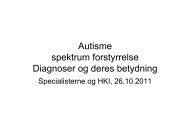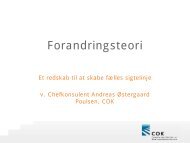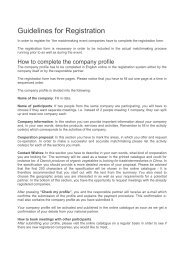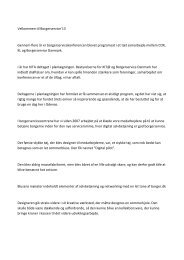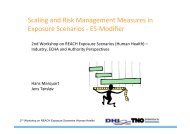11-13 May 2012 Helsingør - Denmark www.networkbio.org
11-13 May 2012 Helsingør - Denmark www.networkbio.org
11-13 May 2012 Helsingør - Denmark www.networkbio.org
You also want an ePaper? Increase the reach of your titles
YUMPU automatically turns print PDFs into web optimized ePapers that Google loves.
ELENA NIKONOVA DIRK fEY† MIKhAIL TSYGANOV‡ BORIS KhOLODENKO<br />
Temporal dynamics of two layer GTPase cascade with GDI binding<br />
GTPases control intracellular signaling and are responsible for a variety of vital cellular mechanisms such<br />
as cytoskeleton formation, motility and vesicle transport. Functioning of GTPases occurs due to monomeric<br />
G proteins cycling between inactive GDP-bound and active GTP-bound states. The reaction is catalyzed<br />
by guanine nucleotide exchange factors (GEFs) for the transformation from GDP to GTP and by GTPase<br />
activating proteins (GAPs) for the reverse transformation. Malfunction of the GTPases often occurs due<br />
to the deregulated expression and activities of GAP and GEF, which was found to be one of the causes of<br />
tumorogenesis [2]. Guanine nucleotide dissociation inhibitors (GDIs) were also found to regulate the GTPase<br />
cycles by binding to the inactive GDB-bound form and transporting the formed complex away from the membrane<br />
to the cytosol. Previous characterization of spatiotemporal dynamics showed that models comprised<br />
of two GTPases without GDI binding can exhibit 3 distinct regimes: sustained oscillations, bistable switches<br />
and excitable behavior [1]. The current work explores the change in dynamics by allowing GDI to bind to<br />
the active and inactive sites of both GTPases. In particular, our results show that as the dissociation and<br />
association rates of GDI binding are varied, the two layer GTPase model can exhibit transformations within<br />
previously outlined regimes.<br />
References<br />
[1] M.A.Tsyganov, W. Kolch and B.N. Kholodenko Molecular BioSystems, <strong>2012</strong>.<br />
[2] D. Vigil, J. Cherfils, K.L. Rossman and C.J. Der Nat. Rev. Cancer, 10(12), 842-857, 2010.<br />
*Systems Biology Ireland, University College Dublin, Belfield, Dublin 4<br />
†Systems Biology Ireland, University College Dublin, Belfield, Dublin 4<br />
‡Institute of Theoretical and Experimental Biophysics, Pushchino, Moscow Region, Russia §Systems Biology<br />
Ireland, University College Dublin, Belfield, Dublin 4<br />
abStractS For PoSterS abStractS For PoSterS<br />
ALExEY GOLTSOV (A), DANA fARATIAN(B), SIMON LANGDON(B), DAVID hARRISON(B), JAMES BOWN(A)<br />
(A) CENTRE fOR RESEARCh IN INfORMATICS AND SYSTEMS PAThOLOGY, UNIVERSITY Of ABERTAY<br />
DUNDEE, DUNDEE, UK (B) EDINBURGh BREAKThROUGh RESEARCh UNIT AND DIVISION Of PAThOLOGY,<br />
WESTERN GENERAL hOSPITAL, UNIVERSITY Of EDINBURGh, EDINBURGh, UK<br />
Systems biology of drug sensitivity-resistance transition in PI3K/AKT signalling in cancer<br />
Systems biology offers a useful approach to study dependence of drug efficacy on oncogene-driven<br />
transformations in drug target pathways relevant to cancer therapy. Systems approach was developed to<br />
elucidate mechanisms underlying the changes of the efficacy of monoclonal antibody therapy (trastuzumab,<br />
pertuzumab) targeting HER2 receptor at cancer genome transformation in the PI3K/AKT signalling network<br />
(SN) [Goltsov et al Cell. Signalling 20<strong>11</strong>]. In silico experiments showed that HER2 inhibition sensitises the<br />
SN both to external signals and to kinetic characteristics of the proteins and their expression levels. We suggested<br />
that a drug-induced increase in SN sensitivity to internal perturbations, and specifically mutations,<br />
causes SN fragility. In particular, the SN is vulnerable to mutations that compensate for drug action and this<br />
may result in a drug sensitivity-to-resistance transition in SN [Goltsov et al Cell. Signalling <strong>2012</strong>]. Modelling<br />
showed the increase of SN sensitivity to typical aberrations in cancer causing drug resistance: loss of<br />
PTEN activity, PI3K and AKT mutations, HER2 overexpression, and overproduction of GSK3ᴅ controlling<br />
PTEN activity. In particular, the SN is vulnerable to mutations that compensate for drug action. PTEN loss or<br />
PIK3CA mutation was shown to cause resistance to HER2 inhibition and leads to the restoration of maximal<br />
pAKT signal with a consequent decrease in SN sensitivity. The drug-induced sensitivity of SN was tested in<br />
experiments on ovarian cancer cells which demonstrated that HER2 inhibition increased SN sensitivity to<br />
the second inhibitor targeting downstream pathway, in particular PI3K inhibition. The developed method is<br />
proposed to be used in the pointed development of combined treatment of cancer which provides both synergetic<br />
inhibition of SN activated in cancer and prevention of the SN from acquired drug resistance caused<br />
by oncogenic mutations.<br />
42 / INB <strong>2012</strong> • <strong>11</strong>-<strong>13</strong> <strong>May</strong> <strong>2012</strong> <strong>www</strong>.<strong>networkbio</strong>.<strong>org</strong> / 43




